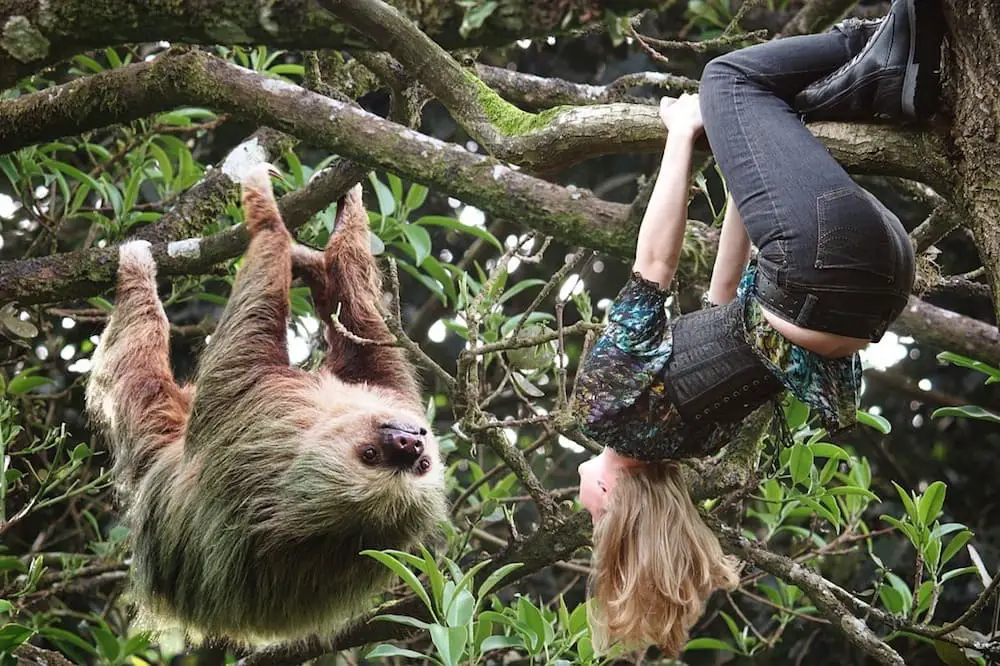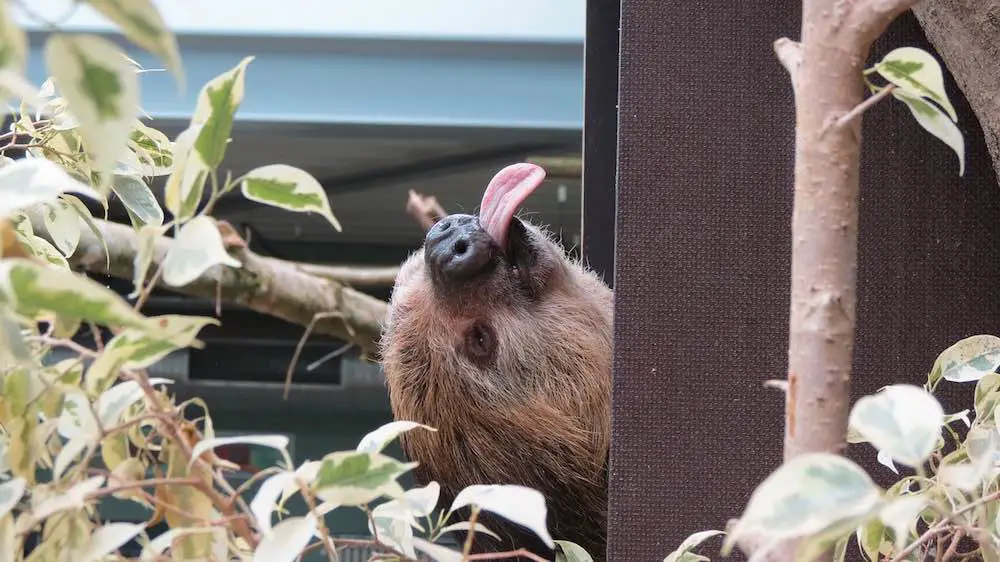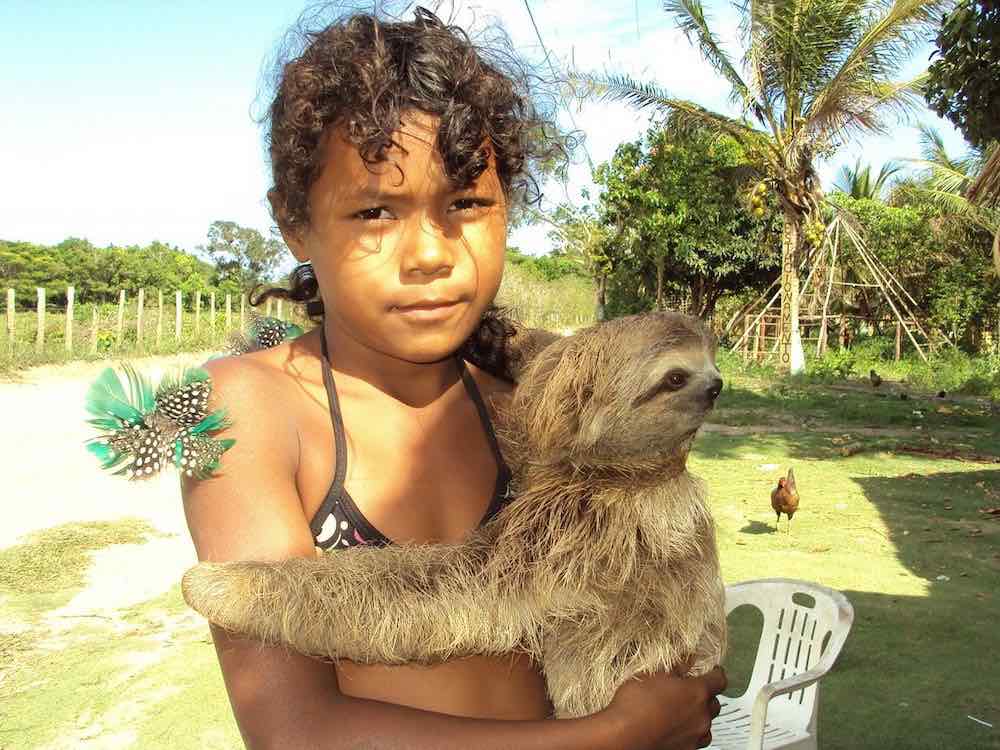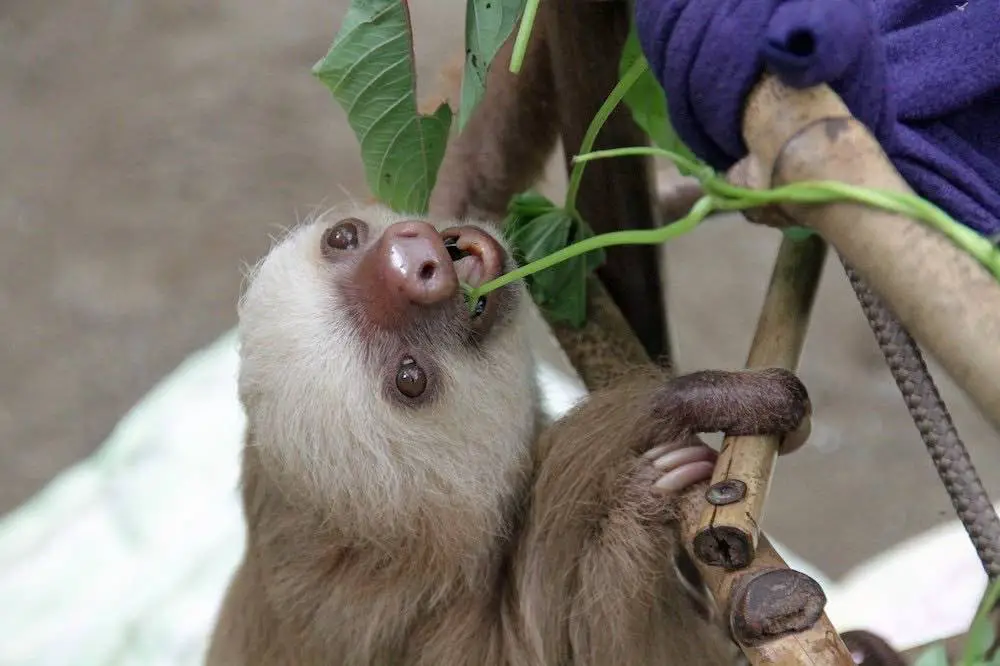
We know sloths are incredibly slow creatures and tend to live alone. But if challenged, are sloths dangerous to humans? Will they attack and can they cause harm?
I did wonder this and did some research to see what I could find out.
So are sloths dangerous to humans? Sloths are not dangerous to humans if left alone in their natural habitat. If threatened they can lash out with their long claws which could cause damage. They can bite, and they can carry diseases harmful to humans. They carry creatures in their fur such as mosquitos which could pass on to humans.
So that’s the answer right there in a nutshell. There is a bit more to it than this, and I have provided some more information below about where exactly you can expect to see each of the different types of sloths, as well as more information about attacking, biting and diseases. Read on to find out more.
Contents
Are Sloths Dangerous To Humans?
This may seem like a bit of an odd question really. I mean, what are the chances of us ever seeing a sloth in real life? I say that, and then immediately I can actually give an example of seeing a sloth in real life.
I visited an animal sanctuary while I was in Mexico a long time ago now, and I did actually get to see a real life sloth close up. It wasn’t however, close enough to touch, so I wasn’t really in any danger in this situation.

Given the fact that they move incredibly slowly, it wasn’t exactly going to chase me. According to Wikipedia sloths move at an average speed of 4 metres per minute. This is not quick at all, and more than enough time for a human to make a getaway.
They can push it to 4.5 metres per minute if they are in danger from a predator, but this is still super slow.
I guess there are really two places you will encounter a sloth, either in the wild, or when a sloth is in captivity. So let’s take the first one. Where do sloths live, and are sloths dangerous to humans if you see them in the wild?
To answer this question, we need to know exactly where sloths live. Did you know that there are actually several different types of sloths?
They are split into two different groups, the two-toed sloth and the three-toed sloth. The names in some ways are misleading, because both of these types of sloth have three toes on their back legs.
It’s just that the two-toed sloth has two on its front legs and the three-toed sloth has three on its front legs. This is just one of the many differences between two-toed and three-toed sloths.
So let’s take a quick look at where each of the different sloths live to see the chance of you running into them in the wild.
Linnaeus’s Two-Toed Sloth
As the name suggest the Linnaeus’s two-toed sloth is a member of the two-toed sloth family. It lives in tropical and subtropical rainforests. It can be found in Brazil, Bolivia, Columbia, Ecuador, The Guyanas and Peru.
Hoffmann’s Two-Toed Sloth
The Hoffmann’s two-toed sloth also likes to live in tropical rainforests, living in the canopies of trees. It can be found in Bolivia, Brazil, Ecuador, Honduras and Peru.
Maned Sloth
The maned sloth is part of the three-toed family of sloths. This one is diurnal, so will come out during the daytime. If you want to see this type of sloth in the wild you will only get the chance if you go to Brazil. It lives specifically in the Atlantic Coastal rainforest of Southeastern brazil.
Pale-Throated Sloth
The pale-throated sloth is also a member of the three-toed sloth family. It gets its name from the light patch of fur on its throat. It lives in the rainforests of Northern South America. More specifically it can be found in Brazil, French Guiana, Guyana, Suriname and Venezuela.
Brown-Throated Sloth
The Brown-Throated sloth, like its name sake above is also a member of the three-toed sloth family. There are actually seven subspecies of this type of sloth.
Due to this they can appear in a great number of counties of Central and South America. You can find them in Brazil, Bolivia, Columbia, Costa Rica, Ecuador, Honduras, Nicaragua, Panama, Peru and Venezuela.
Pygmy Three-Toed Sloth
Also a member of the three-toed sloth family, the pygmy three-toed sloth is much rarer than some of the other sloths above. In fact it is reported that there are less than 100 of these left in the world today.
They live in one very specific area, which is the small Island knows as Isla Escudo de Veraguas off the coast of Panama. They live in a tiny patch approximately 4.3 square kilometres in size, among the reed mangroves found there. This species of sloth in particular spends quite a lot of time swimming in comparison to others.
Do Sloths Attack Humans?
So as you can see from the above, unless you visit these places, or keep a sloth in captivity, the chances of seeing one let alone being attacked by one are fairly slim.
Now sloths are kept in captivity, for varying reasons. Many places, like the one I visited in Mexico keep sloths as attractions for people to see.

Believe it or not people actually do keep sloths as pets as well. Crazy I know, but people do. In my opinion they should not, as taking them away from their natural environment is neither fair or good for animals.
Sloths are solitary creatures. They prefer to be alone, and spend almost all of their time alone. They mostly do this by hanging in trees high up in the canopies of rainforests.
They very rarely come down from these, and in fact only come down to use the toilet on average once a week! Left to their own devices in the wild, are sloths dangerous to humans? Not really.
The act of going to the toilet next to the tree they live in means that sloths can actually help the environment by fertilising trees!
If you approach a sloth while it is in the wild and it feels threatened will it defend itself? Yes it will. It is not really going to be able to chase you.
But it does have strong limbs from climbing trees, and it has extremely long and sharp claws. These aspects of a sloth’s physiology help them adapt to the rainforest.
The claws of a sloth can grow up to four inches, and they could definitely do some damage to you if a sloth was close enough to take a swipe at you.
Like I said, in the wild a sloth is not going to come looking for you to attack you, but if you disturb it and are close to it it a sloth may well try to defend itself by swiping at you. The best way to stop this from happening is to not go close to it.
Now if you have a sloth in captivity, there is much more of a chance of you being attacked by one. I use the word attack, but this is probably quite a strong word. There is no real evidence of sloths going out of their way to attack humans.
Like I said, they are solitary creatures, and as such are not used to seeing humans in the wild. Why would they be? So if you have one in captivity and you are trying to handle it, there is every chance that a sloth will not like this.
While its not going to chase you, if you are handling it and close enough the sloth could definitely take exception to being handled and try to defend itself from what it perceives as a threat. It won’t come looking to attack you for sure, but if it feels threatened it will defend itself.
Do Sloths Bite?
So to answer the question are sloths dangerous to humans we should also have a look at whether or not biting is one of the things we should be concerned about when it comes to handling or being near sloths.

Sloths do have the ability to bite, and if they feel they have been provoked they may do so. The two-toed sloth is more likely to do this than the three-toed sloth. However unless in extreme situations neither is really likely to do this.
It was once thought that sloths actually didn’t have any teeth at all. They certainly have less than we do, but they do have them, and they can still be reasonably sharp. As they mostly eat leaves and plants, they are only really normally used for ripping leaves off trees and chewing them.
The amount of teeth a sloth has ranges between the different types of sloths. The three-toed sloths normally have eighteen teeth.
They have five on each side of the upper jaw and four on each side of the lower jaw. They are normally reasonably rounded in shape. The teeth at the front in the upper jaw are normally smaller than the others.
The Linnaeus’s two-toed sloth has four or five sets of teeth. These are just canine teeth and they do not have incisors. Sloths teeth are not coated in enamel like humans teeth are. They are covered with dentin that is continuously growing.
Do Sloths Carry Diseases?
Another thing we need to think about when we are asking are sloths dangerous to humans is if they carry diseases, and if these can be passed on to humans.
Again, even if they did carry diseases in the wild, as long as they were left alone they would never pass these on to humans. If we did not take them from their habitat and place them in isolation, this would not be something we needed to worry about.
This article that I found while researching this does talk about viruses that sloths carry that are dangerous to humans. Apparently a sloth can host something called an arbovirus that can cause disease in humans and other animals.
According to this article virus detection is very scarce amongst sloths for these types of viruses. However, they have been observed, so if you take a sloth out of its home you are running the risk of spreading this.
Sloths also play host to a great number of parasites in their fur. A sloths fur plays a very important part in helping it to survive. Within the fur grows algae, which gives sloths a green color. This helps a sloth to camouflage itself from any predators whilst hanging in trees. Sloths are so smart!
In some sloths creatures will live in their fur, such as sloth moths and beetles. However they can also play host to other blood sucking flies such as mosquitos, sandflies, lice and ticks. Whilst not particularly dangerous to sloths, these could be passed on to humans if they handled them.
Summing Up
So there you go. I hope I have managed to answer the question are sloths dangerous to humans in enough detail. Quite simply, if they were left alone they would not be dangerous to humans at all.
If left in the wild there would be little chance of running into one. Even if you did, if you kept your distance you would be fine.
If a sloth felt threatened they would be able to lash out with their long claws. This could inflict some damage to a human. They could also bite a human if they were close enough, although not hugely likely.
There is not too much chance of catching diseases from a sloth, although is is possible. They also carry bloodsucking creatures that could be passed on to humans.
Thanks for reading. If you have anything to add to this or would like to ask a question then please leave a comment below.
